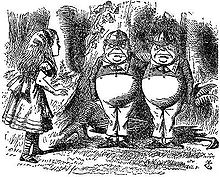Tweedledum and Tweedledee
| "Tweedledum and Tweedledee" | |
|---|---|

John Tenniel's illustration, from Through the Looking-Glass (1871), chapter 4
|
|
| Nursery rhyme | |
| Published | 1805 |
Tweedledum and Tweedledee are fictional characters in an English nursery rhyme and in Lewis Carroll's Through the Looking-Glass, and What Alice Found There. Their names may have originally come from an epigram written by poet John Byrom. The nursery rhyme has a Roud Folk Song Index number of 19800. The names have since become synonymous in western popular culture slang for any two people who look and act in identical ways, generally in a derogatory context.
Common versions of the nursery rhyme include:
The words "Tweedle-dum and Tweedle-dee" make their first appearance in print in "one of the most celebrated and most frequently quoted (and sometimes misquoted) epigrams", satirising the disagreements between George Frideric Handel and Giovanni Bononcini, written by John Byrom (1692–1763):
Although Byrom is clearly the author of the epigram, the last two lines have also been attributed to Jonathan Swift and Alexander Pope. While the familiar form of the rhyme was not printed until around 1805, when it appeared in Original Ditties for the Nursery, it is possible that Byrom was drawing on an existing rhyme.
The characters are perhaps best known from Lewis Carroll's Through the Looking-Glass and what Alice Found There (1871). Carroll, having introduced two fat little men named Tweedledum and Tweedledee, quotes the nursery rhyme, which the two brothers then go on to enact. They agree to have a battle, but never have one. When they see a monstrous black crow swooping down, they take to their heels. The Tweedle brothers never contradict each other, even when one of them, according to the rhyme, "agrees to have a battle". Rather, they complement each other's words. This fact has led Tenniel to assume that they are twins, and Gardner goes so far as to claim that Carroll intended them to be enantiomorphs — three-dimensional mirror images. Evidence for these assumptions cannot be found in any of Lewis Carroll's writings.
...
Wikipedia
